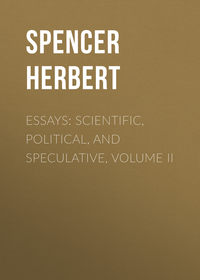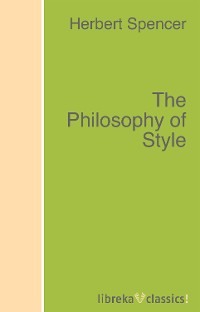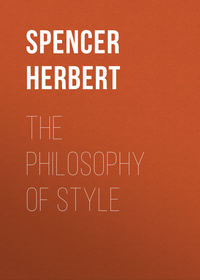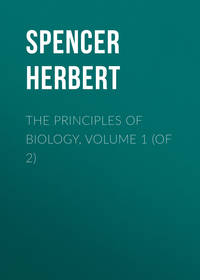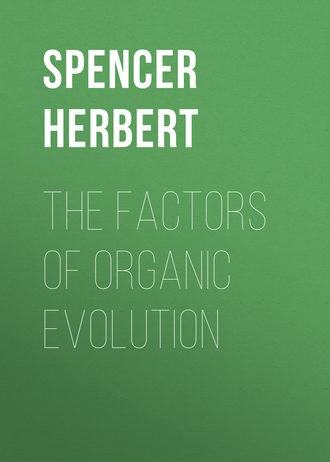 полная версия
полная версияThe Factors of Organic Evolution

Herbert Spencer
The Factors of Organic Evolution
The two parts of which this Essay consists, originally published in The Nineteenth Century for April and May 1886 respectively, now reappear with the assent of the proprietor and editor of that periodical, to whom my thanks are due for his courtesy in giving it. Some passages of considerable length which, with a view to needful brevity, were omitted when the articles first appeared, have been restored.
Though the direct bearings of the arguments contained in this Essay are biological, the argument contained in its first half has indirect bearings upon Psychology, Ethics, and Sociology. My belief in the profound importance of these indirect bearings, was originally a chief prompter to set forth the argument; and it now prompts me to re-issue it in permanent form.
Though mental phenomena of many kinds, and especially of the simpler kinds, are explicable only as resulting from the natural selection of favourable variations; yet there are, I believe, still more numerous mental phenomena, including all those of any considerable complexity, which cannot be explained otherwise than as results of the inheritance of functionally-produced modifications. What theory of psychological evolution is espoused, thus depends on acceptance or rejection of the doctrine that not only in the individual, but in the successions of individuals, use and disuse of parts produce respectively increase and decrease of them.
Of course there are involved the conceptions we form of the genesis and nature of our higher emotions; and, by implication, the conceptions we form of our moral intuitions. If functionally-produced modifications are inheritable, then the mental associations habitually produced in individuals by experiences of the relations between actions and their consequences, pleasurable or painful, may, in the successions of individuals, generate innate tendencies to like or dislike such actions. But if not, the genesis of such tendencies is, as we shall see, not satisfactorily explicable.
That our sociological beliefs must also be profoundly affected by the conclusions we draw on this point, is obvious. If a nation is modified en masse by transmission of the effects produced on the natures of its members by those modes of daily activity which its institutions and circumstances involve; then we must infer that such institutions and circumstances mould its members far more rapidly and comprehensively than they can do if the sole cause of adaptation to them is the more frequent survival of individuals who happen to have varied in favourable ways.
I will add only that, considering the width and depth of the effects which acceptance of one or other of these hypotheses must have on our views of Life, Mind, Morals, and Politics, the question – Which of them is true? demands, beyond all other questions whatever, the attention of scientific men.
Brighton, January, 1887.
I
Within the recollection of men now in middle life, opinion concerning the derivation of animals and plants was in a chaotic state. Among the unthinking there was tacit belief in creation by miracle, which formed an essential part of the creed of Christendom; and among the thinking there were two parties, each of which held an indefensible hypothesis. Immensely the larger of these parties, including nearly all whose scientific culture gave weight to their judgments, though not accepting literally the theologically-orthodox doctrine, made a compromise between that doctrine and the doctrines which geologists had established; while opposed to them were some, mostly having no authority in science, who held a doctrine which was heterodox both theologically and scientifically. Professor Huxley, in his lecture on “The Coming of Age of the Origin of Species,” remarks concerning the first of these parties as follows: —
“One-and-twenty years ago, in spite of the work commenced by Hutton and continued with rare skill and patience by Lyell, the dominant view of the past history of the earth was catastrophic. Great and sudden physical revolutions, wholesale creations and extinctions of living beings, were the ordinary machinery of the geological epic brought into fashion by the misapplied genius of Cuvier. It was gravely maintained and taught that the end of every geological epoch was signalised by a cataclysm, by which every living being on the globe was swept away, to be replaced by a brand-new creation when the world returned to quiescence. A scheme of nature which appeared to be modelled on the likeness of a succession of rubbers of whist, at the end of each of which the players upset the table and called for a new pack, did not seem to shock anybody.
I may be wrong, but I doubt if, at the present time, there is a single responsible representative of these opinions left. The progress of scientific geology has elevated the fundamental principle of uniformitarianism, that the explanation of the past is to be sought in the study of the present, into the position of an axiom; and the wild speculations of the catastrophists, to which we all listened with respect a quarter of a century ago, would hardly find a single patient hearer at the present day.”
Of the party above referred to as not satisfied with this conception described by Professor Huxley, there were two classes. The great majority were admirers of the Vestiges of the Natural History of Creation– a work which, while it sought to show that organic evolution has taken place, contended that the cause of organic evolution, is “an impulse” supernaturally “imparted to the forms of life, advancing them, … through grades of organization.” Being nearly all very inadequately acquainted with the facts, those who accepted the view set forth in the Vestiges were ridiculed by the well-instructed for being satisfied with evidence, much of which was either invalid or easily cancelled by counter-evidence, and at the same time they exposed themselves to the ridicule of the more philosophical for being content with a supposed explanation which was in reality no explanation: the alleged “impulse” to advance giving us no more help in understanding the facts than does Nature's alleged “abhorrence of a vacuum” help us to understand the ascent of water in a pump. The remnant, forming the second of these classes, was very small. While rejecting this mere verbal solution, which both Dr. Erasmus Darwin and Lamarck had shadowed forth in other language, there were some few who, rejecting also the hypothesis indicated by both Dr. Darwin and Lamarck, that the promptings of desires or wants produced growths of the parts subserving them, accepted the single vera causa assigned by these writers – the modification of structures resulting from modification of functions. They recognized as the sole process in organic development, the adaptation of parts and powers consequent on the effects of use and disuse – that continual moulding and re-moulding of organisms to suit their circumstances, which is brought about by direct converse with such circumstances.
But while this cause accepted by these few is a true cause, since unquestionably during the life of the individual organism changes of function produce changes of structure; and while it is a tenable hypothesis that changes of structure so produced are inheritable; yet it was manifest to those not prepossessed, that this cause cannot with reason be assigned for the greater part of the facts. Though in plants there are some characters which may not irrationally be ascribed to the direct effects of modified functions consequent on modified circumstances, yet the majority of the traits presented by plants are not to be thus explained. It is impossible that the thorns by which a briar is in large measure defended against browsing animals, can have been developed and moulded by the continuous exercise of their protective actions; for in the first place, the great majority of the thorns are never touched at all, and, in the second place, we have no ground whatever for supposing that those which are touched are thereby made to grow, and to take those shapes which render them efficient. Plants which are rendered uneatable by the thick woolly coatings of their leaves, cannot have had these coatings produced by any process of reaction against the action of enemies; for there is no imaginable reason why, if one part of a plant is eaten, the rest should thereafter begin to develop the hairs on its surface. By what direct effect of function on structure, can the shell of a nut have been evolved? Or how can those seeds which contain essential oils, rendering them unpalatable to birds, have been made to secrete such essential oils by these actions of birds which they restrain? Or how can the delicate plumes borne by some seeds, and giving the wind power to waft them to new stations, be due to any immediate influences of surrounding conditions? Clearly in these and in countless other cases, change of structure cannot have been directly caused by change of function. So is it with animals to a large extent, if not to the same extent. Though we have proof that by rough usage the dermal layer may be so excited as to produce a greatly thickened epidermal layer, sometimes quite horny; and though it is a feasible hypothesis that an effect of this kind persistently produced may be inherited; yet no such cause can explain the carapace of the turtle, the armour of the armadillo, or the imbricated covering of the manis. The skins of these animals are no more exposed to habitual hard usage than are those of animals covered by hair. The strange excrescences which distinguish the heads of the hornbills, cannot possibly have arisen from any reaction against the action of surrounding forces; for even were they clearly protective, there is no reason to suppose that the heads of these birds need protection more than the heads of other birds. If, led by the evidence that in animals the amount of covering is in some cases affected by the degree of exposure, it were admitted as imaginable that the development of feathers from preceding dermal growths had resulted from that extra nutrition caused by extra superficial circulation, we should still be without explanation of the structure of a feather. Nor should we have any clue to the specialities of feathers – the crests of various birds, the tails sometimes so enormous, the curiously placed plumes of the bird of paradise, &c., &c. Still more obviously impossible is it to explain as due to use or disuse the colours of animals. No direct adaptation to function could have produced the blue protuberances on a mandril's face, or the striped hide of a tiger, or the gorgeous plumage of a kingfisher, or the eyes in a peacock's tail, or the multitudinous patterns of insects' wings. One single case, that of a deer's horns, might alone have sufficed to show how insufficient was the assigned cause. During their growth, a deer's horns are not used at all; and when, having been cleared of the dead skin and dried-up blood-vessels covering them, they are ready for use, they are nerveless and non-vascular, and hence are incapable of undergoing any changes of structure consequent on changes of function.
Of these few then, who rejected the belief described by Professor Huxley, and who, espousing the belief in a continuous evolution, had to account for this evolution, it must be said that though the cause assigned was a true cause, yet, even admitting that it operated through successive generations, it left unexplained the greater part of the facts. Having been myself one of these few, I look back with surprise at the way in which the facts which were congruous with the espoused view monopolized consciousness and kept out the facts which were incongruous with it – conspicuous though many of them were. The misjudgment was not unnatural. Finding it impossible to accept any doctrine which implied a breach in the uniform course of natural causation, and, by implication, accepting as unquestionable the origin and development of all organic forms by accumulated modifications naturally caused, that which appeared to explain certain classes of these modifications, was supposed to be capable of explaining the rest: the tendency being to assume that these would eventually be similarly accounted for, though it was not clear how.
Returning from this parenthetic remark, we are concerned here chiefly to remember that, as said at the outset, there existed thirty years ago, no tenable theory about the genesis of living things. Of the two alternative beliefs, neither would bear critical examination.
Out of this dead lock we were released – in large measure, though not I believe entirely – by the Origin of Species. That work brought into view a further factor; or rather, such factor, recognized as in operation by here and there an observer (as pointed out by Mr. Darwin in his introduction to the second edition), was by him for the first time seen to have played so immense a part in the genesis of plants and animals.
Though laying myself open to the charge of telling a thrice-told tale, I feel obliged here to indicate briefly the several great classes of facts which Mr. Darwin's hypothesis explains; because otherwise that which follows would scarcely be understood. And I feel the less hesitation in doing this because the hypothesis which it replaced, not very widely known at any time, has of late so completely dropped into the background, that the majority of readers are scarcely aware of its existence, and do not therefore understand the relation between Mr. Darwin's successful interpretation and the preceding unsuccessful attempt at interpretation. Of these classes of facts, four chief ones may be here distinguished.
In the first place, such adjustments as those exemplified above are made comprehensible. Though it is inconceivable that a structure like that of the pitcher-plant could have been produced by accumulated effects of function on structure; yet it is conceivable that successive selections of favourable variations might have produced it; and the like holds of the no less remarkable appliance of the Venus's Fly-trap, or the still more astonishing one of that water-plant by which infant-fish are captured. Though it is impossible to imagine how, by direct influence of increased use, such dermal appendages as a porcupine's quills could have been developed; yet, profiting as the members of a species otherwise defenceless might do by the stiffness of their hairs, rendering them unpleasant morsels to eat, it is a feasible supposition that from successive survivals of individuals thus defended in the greatest degrees, and the consequent growth in successive generations of hairs into bristles, bristles into spines, spines into quills (for all these are homologous), this change could have arisen. In like manner, the odd inflatable bag of the bladder-nosed seal, the curious fishing-rod with its worm-like appendage carried on the head of the lophius or angler, the spurs on the wings of certain birds, the weapons of the sword-fish and saw-fish, the wattles of fowls, and numberless such peculiar structures, though by no possibility explicable as due to effects of use or disuse, are explicable as resulting from natural selection operating in one or other way.
In the second place, while showing us how there have arisen countless modifications in the forms, structures, and colours of each part, Mr. Darwin has shown us how, by the establishment of favourable variations, there may arise new parts. Though the first step in the production of horns on the heads of various herbivorous animals, may have been the growth of callosities consequent on the habit of butting – such callosities thus functionally initiated being afterwards developed in the most advantageous ways by selection; yet no explanation can be thus given of the sudden appearance of a duplicate set of horns, as occasionally happens in sheep: an addition which, where it proved beneficial, might readily be made a permanent trait by natural selection. Again, the modifications which follow use and disuse can by no possibility account for changes in the numbers of vertebræ; but after recognizing spontaneous, or rather fortuitous, variation as a factor, we can see that where an additional vertebra hence resulting (as in some pigeons) proves beneficial, survival of the fittest may make it a constant character; and there may, by further like additions, be produced extremely long strings of vertebræ, such as snakes show us. Similarly with the mammary glands. It is not an unreasonable supposition that by the effects of greater or less function, inherited through successive generations, these may be enlarged or diminished in size; but it is out of the question to allege such a cause for changes in their numbers. There is no imaginable explanation of these save the establishment by inheritance of spontaneous variations, such as are known to occur in the human race.
So too, in the third place, with certain alterations in the connections of parts. According to the greater or smaller demands made on this or that limb, the muscles moving it may be augmented or diminished in bulk; and, if there is inheritance of changes so wrought, the limb may, in course of generations, be rendered larger or smaller. But changes in the arrangements or attachments of muscles cannot be thus accounted for. It is found, especially at the extremities, that the relations of tendons to bones and to one another are not always the same. Variations in their modes of connection may occasionally prove advantageous, and may thus become established. Here again, then, we have a class of structural changes to which Mr. Darwin's hypothesis gives us the key, and to which there is no other key.
Once more there are the phenomena of mimicry. Perhaps in a more striking way than any others, these show how traits which seem inexplicable are explicable as due to the more frequent survival of individuals that have varied in favorable ways. We are enabled to understand such marvelous simulations as those of the leaf-insect, those of beetles which “resemble glittering dew-drops upon the leaves;” those of caterpillars which, when asleep, stretch themselves out so as to look like twigs. And we are shown how there have arisen still more astonishing imitations – those of one insect by another. As Mr. Bates has proved, there are cases in which a species of butterfly, rendered so unpalatable to insectivorous birds by its disagreeable taste that they will not catch it, is simulated in its colors and markings by a species which is structurally quite different – so simulated that even a practiced entomologist is liable to be deceived: the explanation being that an original slight resemblance, leading to occasional mistakes on the part of birds, was increased generation after generation by the more frequent escape of the most-like individuals, until the likeness became thus great.
But now, recognizing in full this process brought into clear view by Mr. Darwin, and traced out by him with so much care and skill, can we conclude that, taken alone, it accounts for organic evolution? Has the natural selection of favourable variations been the sole factor? On critically examining the evidence, we shall find reason to think that it by no means explains all that has to be explained. Omitting for the present any consideration of a factor which may be distinguished as primordial, it may be contended that the above-named factor alleged by Dr. Erasmus Darwin and by Lamarck, must be recognized as a co-operator. Utterly inadequate to explain the major part of the facts as is the hypothesis of the inheritance of functionally-produced modifications, yet there is a minor part of the facts, very extensive though less, which must be ascribed to this cause.
When discussing the question more than twenty years ago (Principles of Biology, § 166), I instanced the decreased size of the jaws in the civilized races of mankind, as a change not accounted for by the natural selection of favourable variations; since no one of the decrements by which, in thousands of years, this reduction has been effected, could have given to an individual in which it occurred, such advantage as would cause his survival, either through diminished cost of local nutrition or diminished weight to be carried. I did not then exclude, as I might have done, two other imaginable causes. It may be said that there is some organic correlation between increased size of brain and decreased size of jaw: Camper's doctrine of the facial angle being referred to in proof. But this argument may be met by pointing to the many examples of small-jawed people who are also small-brained, and by citing not infrequent cases of individuals remarkable for their mental powers, and at the same time distinguished by jaws not less than the average but greater. Again, if sexual selection be named as a possible cause, there is the reply that, even supposing such slight diminution of jaw as took place in a single generation to have been an attraction, yet the other incentives to choice on the part of men have been too many and great to allow this one to weigh in an adequate degree; while, during the greater portion of the period, choice on the part of women has scarcely operated: in earlier times they were stolen or bought, and in later times mostly coerced by parents. Thus, reconsideration of the facts does not show me the invalidity of the conclusion drawn, that this decrease in size of jaw can have had no other cause than continued inheritance of those diminutions consequent on diminutions of function, implied by the use of selected and well-prepared food. Here, however, my chief purpose is to add an instance showing, even more clearly, the connexion between change of function and change of structure. This instance, allied in nature to the other, is presented by those varieties, or rather sub-varieties, of dogs, which, having been household pets, and habitually fed on soft food, have not been called on to use their jaws in tearing and crunching, and have been but rarely allowed to use them in catching prey and in fighting. No inference can be drawn from the sizes of the jaws themselves, which, in these dogs, have probably been shortened mainly by selection. To get direct proof of the decrease of the muscles concerned in closing the jaws or biting, would require a series of observations very difficult to make. But it is not difficult to get indirect proof of this decrease by looking at the bony structures with which these muscles are connected. Examination of the skulls of sundry indoor dogs contained in the Museum of the College of Surgeons, proves the relative smallness of such parts. The only pug-dog's skull is that of an individual not perfectly adult; and though its traits are quite to the point they cannot with safety be taken as evidence. The skull of a toy-terrier has much restricted areas of insertion for the temporal muscles; has weak zygomatic arches; and has extremely small attachments for the masseter muscles. Still more significant is the evidence furnished by the skull of a King Charles's spaniel, which, if we allow three years to a generation, and bear in mind that the variety must have existed before Charles the Second's reign, we may assume belongs to something approaching to the hundredth generation of these household pets. The relative breadth between the outer surfaces of the zygomatic arches is conspicuously small; the narrowness of the temporal fossæ is also striking; the zygomata are very slender; the temporal muscles have left no marks whatever, either by limiting lines or by the character of the surfaces covered; and the places of attachment for the masseter muscles are very feebly developed. At the Museum of Natural History, among skulls of dogs there is one which, though unnamed, is shown by its small size and by its teeth, to have belonged to one variety or other of lap-dogs, and which has the same traits in an equal degree with the skull just described. Here, then, we have two if not three kinds of dogs which, similarly leading protected and pampered lives, show that in the course of generations the parts concerned in clenching the jaws have dwindled. To what cause must this decrease be ascribed? Certainly not to artificial selection; for most of the modifications named make no appreciable external signs: the width across the zygomata could alone be perceived. Neither can natural selection have had anything to do with it; for even were there any struggle for existence among such dogs, it cannot be contended that any advantage in the struggle could be gained by an individual in which a decrease took place. Economy of nutrition, too, is excluded. Abundantly fed as such dogs are, the constitutional tendency is to find places where excess of absorbed nutriment may be conveniently deposited, rather than to find places where some cutting down of the supplies is practicable. Nor again can there be alleged a possible correlation between these diminutions and that shortening of the jaws which has probably resulted from selection; for in the bull-dog, which has also relatively short jaws, these structures concerned in closing them are unusually large. Thus there remains as the only conceivable cause, the diminution of size which results from diminished use. The dwindling of a little-exercised part has, by inheritance, been made more and more marked in successive generations.


